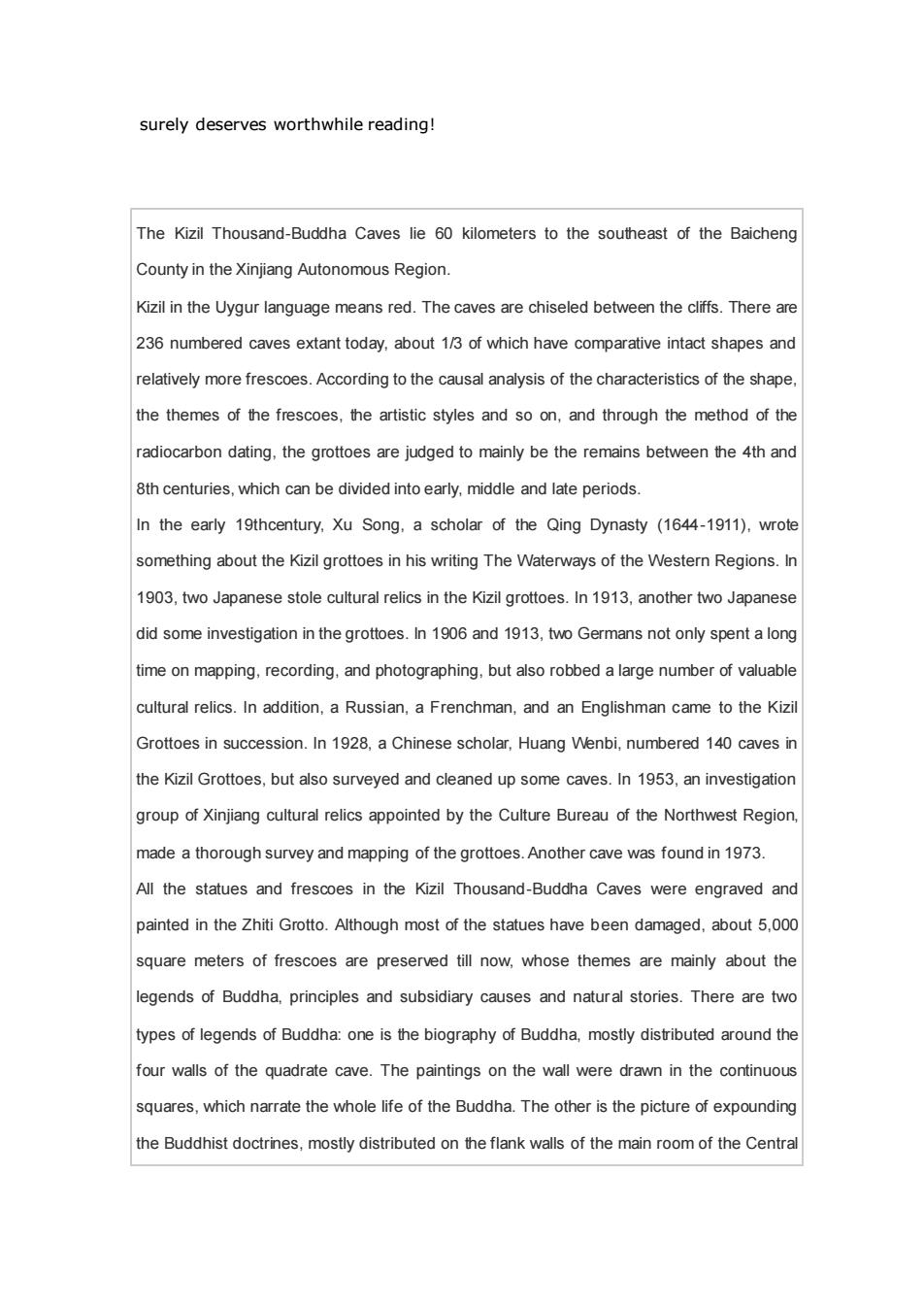正在加载图片...

surely deserves worthwhile reading! The Kizil Thousand-Buddha Caves lie 60 kilometers to the southeast of the Baicheng County in the Xinjiang Autonomous Region. Kizil in the Uygur language means red.The caves are chiseled between the cliffs.There are 236 numbered caves extant today.about 1/3 of which have comparative intact shapes and relatively more frescoes.According to the causal analysis of the characteristics of the shape the themes of the frescoes,the artistic styles and and through the method of the radiocarbon dating.the grottoes are judged to mainly be the remains between the 4th and 8th centuries,which can be divided into early,middle and late periods. In the early 19thcentury.Xu Song.a scholar of the Qing Dynasty (1644-1911).wrote something about the Kizil grottoes in his writing The Waterways of the Western Regions.Ir 1903,two Japanese stole cultural relics in the Kizil grottoes.In1913,another two Japanese did some investigation in the grottoes.In 1906 and 1913,two Germans not only spent a long ime on mapping.recd graphing,but also robbed a large number of valuable cultural relics.In addition,a Russian,a Frenchman,and an Englishman came to the Kizi Grottoes in succession.In 1928.a Chinese scholar,Huang Wenbi,numbered 140 caves in the Kizil Grottoes,but also survey ed and clea aned up some caves.In 1953.an investigation group of Xinjiang cultur appointed by the Culture Bureau of the Northwest Regior made a thorough survey and mapping of the grottoes.Another cave was found in 1973. All the statues and frescoes in the Kizil Thousand-Buddha Caves were engraved and ainted in the Zhiti Grotto.Although most of the statues have been damaged,about 5.000 square meters of frescoes are preserved till now,whose themes are mainly about the legends of Buddha,principles and subsidiary causes and natural stories.There are two types of legends of Buddha:one is the biograph of Buddha,mostly distributed around the four walls of the quadrate cave.The paintings on the wall were drawn in the continuous squares,which narrate the whole life of the Buddha.The other is the picture of expounding the Buddhist doctrines.mostly distributed on the flank walls of the main room of the Centralsurely deserves worthwhile reading! The Kizil Thousand-Buddha Caves lie 60 kilometers to the southeast of the Baicheng County in the Xinjiang Autonomous Region. Kizil in the Uygur language means red. The caves are chiseled between the cliffs. There are 236 numbered caves extant today, about 1/3 of which have comparative intact shapes and relatively more frescoes. According to the causal analysis of the characteristics of the shape, the themes of the frescoes, the artistic styles and so on, and through the method of the radiocarbon dating, the grottoes are judged to mainly be the remains between the 4th and 8th centuries, which can be divided into early, middle and late periods. In the early 19thcentury, Xu Song, a scholar of the Qing Dynasty (1644-1911), wrote something about the Kizil grottoes in his writing The Waterways of the Western Regions. In 1903, two Japanese stole cultural relics in the Kizil grottoes. In 1913, another two Japanese did some investigation in the grottoes. In 1906 and 1913, two Germans not only spent a long time on mapping, recording, and photographing, but also robbed a large number of valuable cultural relics. In addition, a Russian, a Frenchman, and an Englishman came to the Kizil Grottoes in succession. In 1928, a Chinese scholar, Huang Wenbi, numbered 140 caves in the Kizil Grottoes, but also surveyed and cleaned up some caves. In 1953, an investigation group of Xinjiang cultural relics appointed by the Culture Bureau of the Northwest Region, made a thorough survey and mapping of the grottoes. Another cave was found in 1973. All the statues and frescoes in the Kizil Thousand-Buddha Caves were engraved and painted in the Zhiti Grotto. Although most of the statues have been damaged, about 5,000 square meters of frescoes are preserved till now, whose themes are mainly about the legends of Buddha, principles and subsidiary causes and natural stories. There are two types of legends of Buddha: one is the biography of Buddha, mostly distributed around the four walls of the quadrate cave. The paintings on the wall were drawn in the continuous squares, which narrate the whole life of the Buddha. The other is the picture of expounding the Buddhist doctrines, mostly distributed on the flank walls of the main room of the Central